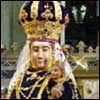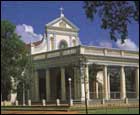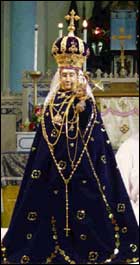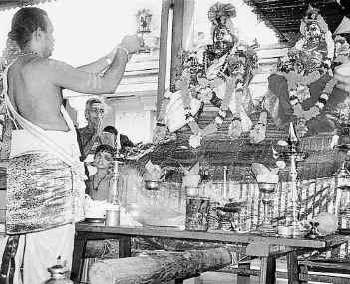Ilankai Tamil Sangam29th Year on the Web Association of Tamils of Sri Lanka in the USA |
|||||||||
 Home Home Archives Archives |
The Temporal and Spiritual Conquest of the TamilsMahinda's 'Book of Dreams'by TamilNet, April 4, 2008
More than security concerns, the sentiments of Tamil Christians and their mistrust of Sri Lankan State seem to be the impelling force behind the decision of taking away Our Lady of Madu from her abode. Those who could look at how Kathirkaamam was confiscated from the predominance of Tamils and how the ancient temples behind the Tamil Saiva myth are inside ‘High Security Zones’, could understand the fear of Tamil Christians. The question is whether the International Community and India, which contribute to the military option, don’t understand or don’t want to understand the fact that if there is anything to be defeated militarily in Sri Lanka, it is the chauvinism of the Sri Lankan State. To a Tamil mind it reminds of the plight of the two chief deities of Tamil Saivism and Vaishnavism, who had to be carried away to escape vandalism at the hands of the Muslim rulers of medieval times. Arangkan (Sri Rangkanaathar of Sri Rangkam) had to flee to Thiruppathi, Saligramam and Chegnchi and Ampalavan (Nadaraja of Chithamparam) had to find sanctuary in Thiruvaaroor. It took a pan-south Indian resistance movement to reinstate Arangkan and there is rooted the birth of the Vijayanagara Empire. The Tamil identity is secular. It doesn’t have any particular religion. Tamil served as the medium for all the major religions of the world since very old times, which is a unique attribute to a language and the identity associated with it. To a Tamil mind, the self-respect of one’s freedom to follow any faith in his or her language and cultural context is what matters. Tamil Christianity in Sri Lanka today is an integral part of Eezham Tamil identity. Contrary to the impression of many, Christianity hasn’t come into Tamil heritage with the advent of the Portuguese. It had come long before, almost at the time of the birth of Christianity in West Asia. It made an impact and survived in the old Tamil society, the descendents of which are the Syrian Christians of Malabar.
When the Roman Catholic faith came along with the Portuguese to Asia, Mannaar, associated with the activities of St. Francis Xavier, was one of the first centres – a Tamil Christian centre, established through martyrdom. For centuries, the Tamil Christian heritage of Mannaar has evolved its own culture, literature, art forms etc. The origins of the icon of Our Lady of Madu go back to the times of the advent of Catholic Christianity in Mannaar. In the 16th century, the image, which was then known as Our Lady of Good Health, was in a church at Maanthai. The persecution of Catholics by the Dutch in the 17th century made her worshippers to carry her deep into Vanni in the year 1670. She was kept at a place, Marutha-madu (meaning, the deep tank in the locality of Maruthu / Terminalia arjuna trees), which at that time was in the border of the territories of the king of Kandy. The settlement soon received further Catholic refugees from Jaffna, fleeing Dutch persecution.
A lady among the latter group called Santa Lena (St Helena) built a humble church for the statue, which then became Our Lady of Madu. Over the centuries Madu became the most important pilgrim centre for Catholics, both Tamils and Sinhalese, throughout Sri Lanka. Many, who have not grasped the undercurrents, may wonder at the necessity to carry the image away when the church is a pan-Sri Lankan pilgrim centre. They may ask whether the Sri Lankan state is incapable of protecting it. Of course there is insecurity in wartime, especially when having a State with credentials of committing destruction to Christian and Hindu places of worship. But, more than the fear of destruction, the pricking question now it seems, is the attempt of the Sinhala nation to confiscate pilgrim sites, and Sinhalicise them, to deal with myths counter to it. Most of the Sinhala Catholics, who make pilgrimage to Madu, were Tamils three or four generations ago. They come from the coastal areas of the Northwestern and Western Provinces. All along the western coast, up to Colombo, there were traditional villages of Tamil Christians. Their Sinhalicisation was systematic, abetted by an ingenious scheme of disruption of communication. The closing down of the traditional coastal highway between Colombo and Mannaar / Jaffna, in the guise of the Wilpattu sanctuary, cut down the contiguity [of the area]. What happened in the western coast is actually the forerunner to what happened and what is happening to the geographical contiguity of Tamils in the East. Through a state-orchestrated process, involving competition for fishing grounds, the third generation [on the western coast] not only became Sinhalese, but also anti-Tamil. The churches, which until recent times conducted masses in Tamil, switched over entirely to Sinhala, signifying a wedge between Tamil and Sinhala Christianity. The matter didn’t stop there. The Sinhala Buddhists have not accepted them [the Christians of the western coast] fully, just because they speak Sinhala. Frictions are not uncommon in this part of the Island. More than security concerns, the sentiments of Tamil Christians and their mistrust of the Sri Lankan State seem to be the impelling force behind the decision to take away Our Lady of Madu from her abode. They trust the secularism of the LTTE better. Those who could look at how Kathirkaamam (Kataragama), once the most favoured pilgrim place for Tamil Saivites, has been confiscated from their predominance and how all the ancient temples behind the Tamil Saiva myth, such as Thiruketheesvaram (Maanthai), Thirukkoa’nesvaram (Trincomalee), Nakuleasvaram (Keerimalai) and Maaviddapuram are denied to devotees, being inside of ‘High Security Zones’, could understand the fear of Tamil Christians about Madu.
The question is whether the International Community and India, which contribute to the military option of Sri Lanka, don’t understand or don’t want to understand the fact that if there is anything to be defeated militarily in Sri Lanka, it is the chauvinism of the Sri Lankan State.
| ||||||||
 Our Lady of Madu has become a refugee in her own land, the Bishop of Mannaar said on Thursday.
Our Lady of Madu has become a refugee in her own land, the Bishop of Mannaar said on Thursday.

